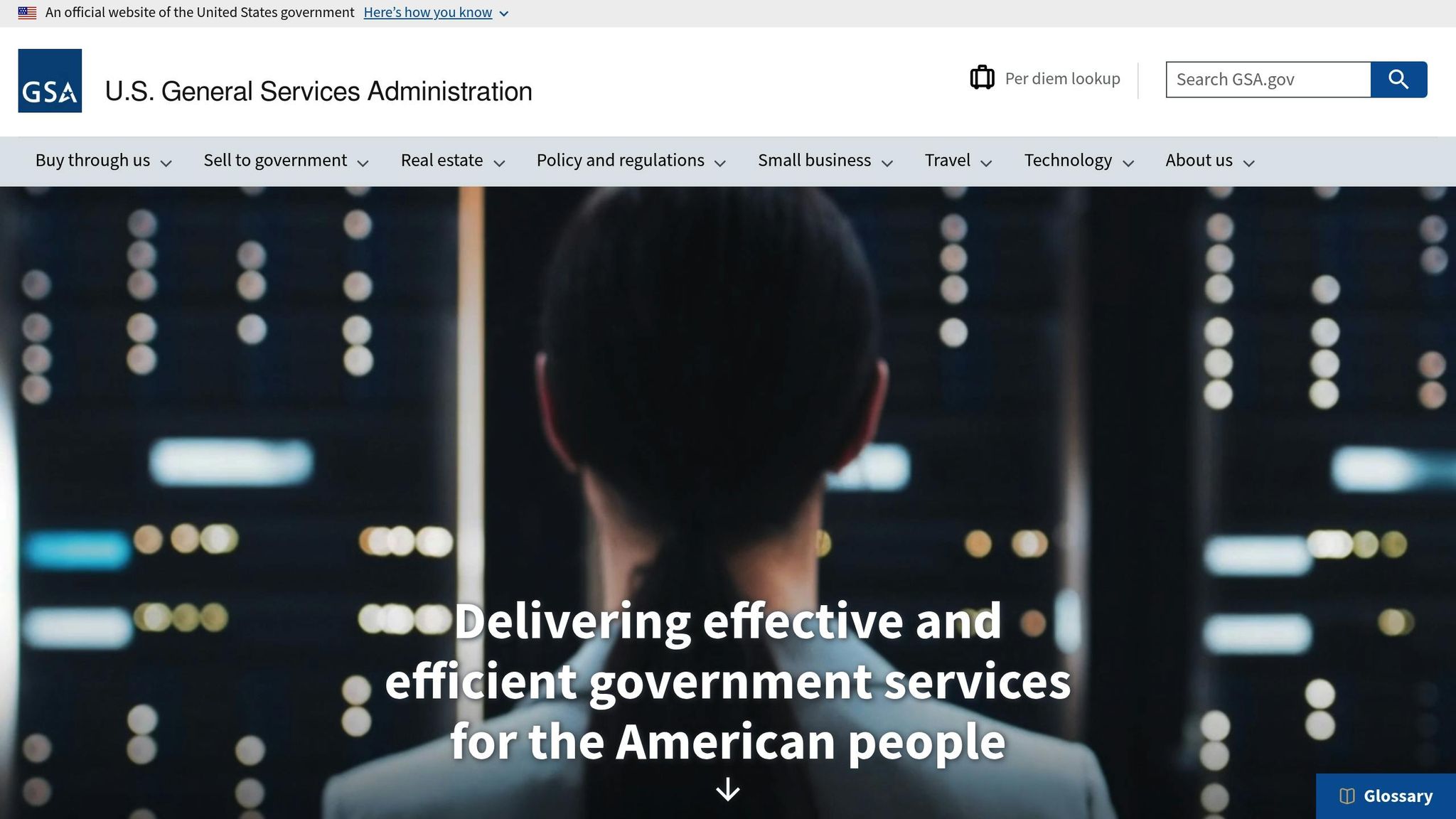Federal procurement in 2025 presents both opportunities and challenges for small businesses. With the U.S. government allocating billions annually for contracts, staying informed and prepared is key to success. Here’s what you need to know:
- Small Business Awards: In FY 2024, small businesses received $176.4 billion in contracts, 23.3% of the $774 billion total.
- Market Shifts: Federal spending increased by 6.5% in early 2025, despite budget reallocations. Defense, IT, and cybersecurity remain top priorities.
- Policy Updates: New SBA goals and Executive Order 14275 aim to simplify regulations and shift focus toward underutilized programs like HUBZone contracts.
- Technology Advances: AI, cloud solutions, and zero-trust security models are reshaping procurement, offering new opportunities for tech-focused businesses.
- Contract Bundling: Larger, consolidated contracts are becoming more common, requiring small businesses to form partnerships or specialize to compete.
- Compliance: Cybersecurity standards like NIST 800-171 and CMMC 2.0 are mandatory, with compliance costs ranging from $15,000 to $50,000 for small firms.
Key Takeaways:
- Explore subcontracting opportunities with larger contractors.
- Leverage federal certifications (8(a), WOSB, HUBZone) to access set-aside contracts.
- Use platforms like SAM.gov and SBA resources for market research and networking.
- Focus on compliance and supply chain security to meet federal standards.
- Consider GSA Schedule Contracts for streamlined access to federal buyers.
Small businesses that stay informed and strategically approach federal procurement can secure a share of this evolving market.
FedBiz’5 Podcast | Episode 59: 2024 Year-End Wrap-Up for Government Contractors + A Look Forward
Federal Procurement Market Overview for 2025
The federal procurement market in 2025 is undergoing noticeable shifts. During the first 100 days of the year, federal procurement spending increased by 6.5% compared to the same period in 2024. While budget cuts have been implemented, strategic reallocations are reshaping spending priorities. These changes open new doors – and present fresh challenges – for small businesses working in federal contracting.
"Government cutbacks don’t shrink the contracting pie – they shift how it’s sliced. Most federal dollars aren’t controversial – they’re mission-critical. While the headlines scream austerity, what’s really happening is a reallocation, not a retreat."
- Michael LeJeune, Partner & Federal Access Program Manager at RSM Federal
In fiscal year 2024, the federal government awarded $773.68 billion in contracts, with small businesses securing $176.11 billion of that total – an increase of nearly $4 billion from 2023. Defense agencies accounted for the largest share, awarding $464.2 billion, which represents 59.87% of all federal contracts.
The following sections explore the driving forces behind these changes, including policy updates, spending trends, and technological advancements.
New Government Policies
The Small Business Administration (SBA) has made notable adjustments to its contracting goals. Under the leadership of Administrator Kelly Loeffler, the agency has reset the small disadvantaged business (SDB) contracting goal to its statutory level of 5%. This marks a departure from previous years, such as fiscal year 2023, when agencies awarded $76.2 billion to SDBs. Moving forward, there’s likely to be increased focus on other areas, such as HUBZone contracts, where the government has historically fallen short of its 3% prime contract goal.
"By lowering the SDB goal, agencies will likely turn their focus away from 8(a) concerns to other areas where they struggle, such as HUBZone, where the government has never met the 3% prime contract goal."
- Former SBA Official
Additionally, Executive Order 14275, issued by President Trump, aims to simplify the Federal Acquisition Regulation (FAR). The order mandates that the FAR should include only provisions required by law or essential for sound procurement practices, removing unnecessary elements. This could influence the Rule of Two, which previously helped small businesses capture 65% of set-aside contracting dollars in 2023.
The Department of Government Efficiency (DOGE) has also directed agencies to review their contracts to identify opportunities for termination or modification, signaling a more strategic approach to procurement.
Government Spending Patterns
Spending trends reveal the federal government’s evolving priorities for 2025. Facilities and Construction lead the way, accounting for 17.07% of total contract awards, followed by Professional Services, IT, and Medical sectors. The administration’s focus on boosting domestic manufacturing and economic growth is creating new opportunities for U.S.-based manufacturers and suppliers. Key growth areas include:
- Domestic manufacturing
- Digital infrastructure and AI development
- Defense modernization
- Cybersecurity
The DOGE budget emphasizes defense spending, cybersecurity, artificial intelligence, border security, and select infrastructure projects. While the total number of federal contracts is expected to decline in fiscal year 2025, there’s a growing reliance on Government-Wide Acquisition Contracts (GWACs) and Indefinite Delivery/Indefinite Quantity (IDIQ) contracts.
Beyond federal spending, the state, local, and education (SLED) market is also expanding. Projections indicate growth from $74 billion in 2024 to nearly $100 billion by 2026.
Technology Changes in Procurement
Technology is fundamentally reshaping federal procurement processes. Advances in AI, cloud computing, 5G, and cybersecurity are driving agencies to adopt more agile approaches. The Office of Management and Budget (OMB) has introduced new policies aimed at streamlining the adoption of these technologies, including the Revolutionary FAR Overhaul (RFO) initiative.
"Federal agencies have experienced a widening gap in adopting AI and modernizing government technology, largely due to unnecessary bureaucracy and outdated procurement processes. OMB’s new policies demonstrate that the government is committed to spending American taxpayer dollars efficiently and responsibly, while increasing public trust through the Federal use of AI."
- Greg Barbaccia, Office of the Federal Chief Information Officer
The RFO initiative, launched by GSA, OMB, NASA, and the Department of Defense, focuses on cutting red tape, increasing transparency, and modernizing procurement processes. Agencies are now required to deliver Minimum Viable Products (MVPs) within 12 months, emphasizing speed and efficiency. Flexible procurement tools like Other Transaction Authorities (OTAs) and Commercial Solutions Openings (CSOs) are becoming standard, with a new preference for commercial solutions.
Federal agencies are also transitioning from traditional IT systems to scalable cloud solutions. Zero-trust security models and blockchain technology are being adopted to ensure secure transactions. According to the Government Accountability Office (GAO), addressing inefficiencies in IT operations could save the federal government over $100 billion. For small businesses that can offer cutting-edge, agile solutions, this shift presents significant opportunities to support the government’s modernization efforts.
Major Federal Procurement Trends for Small Businesses
Federal contracting in 2025 is undergoing significant shifts, creating both challenges and opportunities for small businesses. To stay competitive in this evolving landscape, businesses must adapt their strategies to meet these changes head-on.
Contract Bundling Increases
The rise in contract bundling is one of the most notable changes, with consolidated federal contracts increasing twentyfold between 2010 and 2023. This practice merges multiple smaller contracts into larger, more complex agreements, fundamentally altering how small businesses compete for federal work.
Over the past decade, the federal government has seen a sharp decline in suppliers and service providers – losing over 90,000 during that period. Bundled contracts often require broader capabilities, larger teams, higher financing, and specialized expertise, making it harder for smaller firms to compete.
"The small businesses most impacted are typically the most nimble, innovative, and customer-service-oriented firms. This means that over time, taxpayers, through the government, pay higher prices for less innovation, less quality, and a less competitive marketplace." – Bibi Hidalgo
Federal agencies are required to justify contract bundling by showing measurable benefits over smaller, separate contracts. For small businesses, adapting to this trend may involve forming strategic partnerships, expanding their service offerings, or focusing on niche markets less affected by bundling.
The data paints a stark picture: Native entity enterprises captured only 4.6% of consolidated contract dollars in 2023, amounting to $736.6 million, and from 2010 to 2023, they secured just 2.6% of prime consolidated contract awards. In addition to bundling, stricter security standards are now reshaping the federal procurement landscape, adding another layer of complexity for market entry.
Supply Chain Security Requirements
Supply chain security has become a critical compliance factor in government contracting. The adoption of NIST 800-171 standards and the upcoming Cybersecurity Maturity Model Certification (CMMC) 2.0 are setting new benchmarks for contractors.
By January 4, 2027, all IoT devices sold to the federal government must carry the US Cyber Trust Mark. This reflects the government’s increasing focus on supply chain integrity, driven by a 300% surge in cyberattacks over recent years. In 2021 alone, Americans lost more than $5.8 billion to fraud – up $2.4 billion from the previous year.
While compliance costs can be steep, they are within reach for most small businesses. For companies with 10–50 employees, the initial cost of achieving NIST 800-171 compliance typically ranges from $15,000 to $50,000, with timelines of 3–12 months.
To meet these new requirements, small businesses need to take proactive steps such as conducting regular risk assessments, implementing access controls, monitoring their vendors, and creating robust incident response plans. The shift toward "rules as code" is also transforming compliance verification, making it more automated and objective.
Recent developments highlight the urgency of these measures. In May 2025, Danish officials uncovered unexplained electronic components in energy equipment, raising alarms about supply chain vulnerabilities. For small businesses, this underscores the importance of vetting overseas suppliers and ensuring they are not linked to sanctioned entities.
These trends in contract bundling and supply chain security are reshaping the federal procurement environment. Small businesses that adapt quickly and strategically will position themselves to thrive despite the challenges.
sbb-itb-8737801
Small Business Federal Contracting Success Methods
Breaking into the federal contracting world can be a game-changer for small businesses. With the government allocating over $600 billion annually for contracts and setting aside 25% of prime contracts for small businesses, the opportunities are immense – but so are the challenges. To navigate this competitive space, businesses need a clear strategy, including certifications, partnerships, and market research. Let’s dive into how these methods can set your business apart.
Small Business Certifications Benefits
Federal certifications provide small businesses with a competitive edge by granting access to exclusive contract opportunities. These certifications open doors to set-aside contracts, where only certified businesses can compete.
- 8(a) Business Development Program: Designed for socially and economically disadvantaged businesses, this program reserves a portion of federal contracts specifically for 8(a) certified companies. Each year, the government allocates at least 5% of contracting dollars – about $30 billion – to these businesses. While the certification doesn’t guarantee contracts, it provides a strong platform to pursue them.
- Women-Owned Small Business (WOSB): This certification focuses on contracts where the government aims to award at least 5% of federal contracting dollars annually to women-owned businesses.
- HUBZone Certification: Unlike other certifications that focus on ownership demographics, HUBZone certification is based on location. Businesses must operate in historically underutilized business zones and employ workers from those areas. The program targets 3% of federal contract dollars each year.
- Small Disadvantaged Business (SDB): Capturing the largest share of set-aside opportunities, SDB-certified businesses receive roughly 10% of contracting dollars annually, amounting to about $50 billion.
| Certification Type | Annual Goal | Key Requirement |
|---|---|---|
| Small Disadvantaged Business | 10% | Social and economic disadvantage |
| Women-Owned Small Business | 5% | 51% women ownership |
| Service-Disabled Veteran-Owned | 5% | Veteran with service-connected disability |
| HUBZone | 3% | Operate in designated areas |
To make the most of these certifications, businesses should apply through SBA.gov or VetCert, update their SAM.gov profiles with relevant NAICS codes, and register in the Dynamic Small Business Search database. Many small businesses qualify for multiple certifications, so explore all options that align with your business. These certifications are a stepping stone to tapping into federal procurement opportunities.
Partnerships and Subcontracting Opportunities
Subcontracting offers a lucrative pathway for small businesses, with approximately 30% of subcontracting dollars – around $72 billion in FY 2021 – flowing to small businesses. Federal rules require large businesses to include small firms in contracts exceeding the simplified acquisition threshold, creating consistent opportunities for collaboration.
To find subcontracting opportunities, start with resources like the SBA’s SubNet database, where large businesses post subcontracting solicitations. Additionally, agencies like the General Services Administration (GSA), Department of Transportation (DOT), and Department of Defense (DoD) maintain directories that connect small businesses with prime contractors.
Your Small Business Search (SBS) profile acts as your digital storefront for prime contractors. Ensure it includes:
- Socioeconomic certifications
- A capabilities narrative
- Relevant keywords
- NAICS codes
- Performance history
A 2023 Department of Defense study highlighted challenges for subcontractors, noting that:
"Defense subcontractors and suppliers generally do not receive the favorable cash flow benefits to the same extent enjoyed by defense prime contractors,"
even though subcontractors handle 60% to 70% of defense work.
Building strong partnerships requires more than just a profile. Attend SBA matchmaking events and agency industry days to connect with potential collaborators. For personalized guidance, reach out to APEX Accelerators (formerly Procurement Technical Assistance Centers). Before committing to any partnership, evaluate how it aligns with your business goals and assess both your and the prime contractor’s capabilities.
Market Research and Competitor Analysis
Market research is the backbone of a successful federal contracting strategy. Platforms like SAM.gov provide a wealth of information on contracts over $25,000, while agency forecasts offer insights into upcoming opportunities. Use SAM.gov’s filters to identify small business–friendly RFPs and monitor which companies are winning contracts in your niche.
The Small Business Search database is another valuable tool. Not only can agencies use it to find contractors, but you can also research competitors and identify potential teaming partners. This allows you to understand the competitive landscape and position your business effectively.
Documenting past performance is critical for scaling your federal contracting efforts. Agencies place significant weight on previous government work when evaluating proposals. Maintain a detailed record of completed projects to strengthen your proposals for larger opportunities.
Many federal agencies also have dedicated small business offices that provide direct access to decision-makers and insights into upcoming contracts. Staying consistent with your research efforts is key – ensure your SAM.gov registration and certifications are always up to date, as outdated information could disqualify you from opportunities. By combining certifications, partnerships, and targeted market research, you can position your business to thrive in the federal marketplace.
GSA Schedule Contracts for Federal Market Access

GSA Schedule Contracts offer small businesses a direct route into the vast federal marketplace. These Multiple Award Schedule (MAS) Contracts, managed by the General Services Administration (GSA), are long-term agreements with pre-negotiated pricing and delivery terms, making them a crucial tool for navigating federal procurement. As federal buying evolves, these contracts continue to play a central role in meeting the needs of government agencies.
The numbers speak volumes about the program’s impact. In fiscal year 2024, the GSA MAS program recorded over $51.9 billion in sales, with small businesses accounting for $18.2 billion of that total. Each year, GSA partners with more than 2,600 small and disadvantaged business vendors, highlighting its commitment to supporting diverse suppliers.
GSA Schedule Contract Benefits
For small businesses, GSA Schedule Contracts remove many hurdles often associated with federal procurement. Through a single contract, vendors gain access to every federal agency. Tools like GSA Advantage! and eBuy enhance product visibility and simplify the bidding process. Additionally, competition is more targeted, as agencies typically seek bids only from vendors within specific schedule categories.
The streamlined processes of GSA Schedules significantly reduce the time it takes to secure sales compared to traditional procurement methods. As GSA puts it:
"GSA’s MAS Schedule program is the preferred method of procurement for the federal government. Federal agencies prefer to buy from MAS Schedule contract holders because they know they are getting approved products and services. Also, it means GSA has done all the legwork for them and negotiated the best price and the best value for their dollar."
These contracts are also recognized as Tier 2 Solutions under the Governmentwide Category Management initiative, reinforcing their importance in federal procurement. With a potential 20-year period of performance – five years initially, followed by three five-year renewal options – they provide long-term stability. This framework sets the stage for specialized services to help businesses navigate the complexities of GSA contracts.
GSA Focus Contract Management Services

Securing and managing a GSA Schedule Contract can be challenging, requiring thorough documentation, compliance, and ongoing administration. GSA Focus simplifies this process with a comprehensive, all-in-one service designed to handle every step of the GSA contracting journey.
From document preparation to ensure compliance with GSA standards to managing submission deadlines, GSA Focus streamlines the entire process. Their expertise extends to maintaining compliance throughout the contract’s lifecycle, including managing reporting, price updates, and regulatory requirements. During the award phase, they assist with negotiations, addressing pricing adjustments, contract terms, and additional documentation requests. With a 98% success rate and a refund guarantee, GSA Focus has proven its ability to navigate the intricacies of GSA contracts.
Beyond acquisition, GSA Focus provides marketing services to maximize the value of your contract. They optimize your GSA Advantage listing, conduct outreach to federal buyers, and implement strategies that drive sales. A secure online platform simplifies communication, document uploads, and task management, ensuring a smooth transition to day-to-day contract management.
GSA Schedule Contract Management Tips
Managing a GSA Schedule Contract effectively requires a proactive and organized approach. Once awarded, review all contract documents carefully and establish clear communication with your Procurement Contracting Officer (PCO).
Create a detailed GSA Contract Administration Plan and assign dedicated staff to oversee tasks. Digital tools can help streamline document management and reporting. For instance, the Vendor Support Center offers online tools for tracking and reporting sales, while regular updates to your GSA Advantage catalog ensure your products remain visible to buyers.
Staying compliant is critical. Keep up with changes in GSA regulations and reporting requirements to avoid violations. For contracts over $750,000, the Small Business Subcontracting Program requires non–small businesses to consider partnerships with small businesses, opening additional opportunities for GSA Schedule holders.
Marketing is equally important. Ensure your products and services are well-represented on GSA Advantage to make it easier for government buyers to find and evaluate your offerings. Consider direct outreach through agency contacts, trade shows, and digital marketing to increase your contract’s visibility.
Building strong relationships with key GSA personnel, such as your Administrative Contracting Officer (ACO) and Industrial Operations Analyst (IOA), can help you navigate contract modifications and resolve issues faster. Additionally, GSA’s free online and regional training programs are valuable resources for staying informed about updates and best practices.
Finally, regularly assess your contract’s performance. Monitor sales metrics, collect customer feedback, and evaluate your pricing to stay competitive. These insights can guide decisions about contract modifications, new product offerings, and marketing strategies, ensuring you get the most out of your GSA Schedule Contract.
Federal Procurement 2025: Main Points for Small Businesses
The federal procurement landscape in 2025 offers both opportunities and hurdles for small businesses. In fiscal year 2023 alone, over $160 billion in federal contracts were awarded to small businesses, highlighting the market’s scale. However, the competition is growing fiercer. Here’s a breakdown of how emerging mandates and shifts in priorities could shape your contracting strategy.
Strengthening Supply Chains
Supply chain resiliency has become a top priority. Tighter "Buy American" policies and stricter Trade Agreements Act (TAA) requirements mean small businesses need to evaluate and fortify their supply chain operations to stay compliant. This shift emphasizes the importance of sourcing and transparency in meeting federal standards.
AI and Emerging Technologies
Federal agencies are increasingly investing in AI-enabled solutions, creating new opportunities for tech-savvy small businesses. However, this trend may also bring regulatory changes, including stricter trade controls with countries like China in the realm of AI. Businesses that can offer innovative AI products or services may find themselves in high demand.
Cybersecurity Compliance
Cybersecurity remains a cornerstone of federal contracting. New initiatives, such as the Cybersecurity Maturity Model Certification (CMMC) and FAR Case 2021-017, require contractors to maintain rigorous cybersecurity measures to qualify for federal opportunities. Staying ahead in this area is essential for eligibility.
Changes to the MAS Program
The General Services Administration (GSA) is making the Multiple Award Schedule (MAS) program more transparent. By publishing contractor performance data and consolidating Economic Price Adjustment clauses, the GSA is increasing scrutiny on compliance with TAA practices and documentation. Businesses must pay close attention to these updates to remain competitive.
Subcontracting as a Key Strategy
Subcontracting is emerging as a critical pathway for small businesses. Prime contractors are actively seeking partners to expand their capabilities and qualify for more opportunities. Shauna Weatherly, President of FedSubK, underscores this point:
"Subcontracting’s a lucrative business in the federal space. It’s not just prime… there’s a lot of avenues and entry points".
For small businesses, this means subcontracting can provide a valuable entry point into federal markets, especially for those not yet ready to compete as prime contractors.
Diversify and Adapt
Relying solely on set-aside contracts is no longer a sustainable approach. Industry experts stress that small businesses must embrace flexibility and invest in compliance, technology, and partnerships to thrive in the evolving federal procurement environment. By proactively addressing these changes, businesses can position themselves to succeed in this competitive space.
FAQs
How can small businesses navigate the challenges of contract bundling in federal procurement?
Small businesses can tackle the challenges of contract bundling by adopting a thoughtful and well-planned approach. Begin by diving into the federal marketplace to grasp how bundling affects opportunities and pinpoint contracts that fit your business’s strengths. Collaborating with other small businesses or teaming up as a subcontractor with larger firms can make your bids more competitive and increase your chances of success.
Understanding federal acquisition regulations tied to bundling is equally important – compliance plays a crucial role in securing contracts. Keep an eye on procurement trends and shifting government priorities, as staying informed allows you to adjust your strategies and stay ahead in the federal contracting game. With careful preparation and a focus on collaboration, small businesses can transform the hurdles of bundling into pathways for growth.
What steps should small businesses take to comply with cybersecurity standards like NIST 800-171 and CMMC 2.0?
To meet the requirements of NIST 800-171, small businesses need to start by figuring out if they handle Controlled Unclassified Information (CUI). This is the key factor that triggers the need for compliance. The first step? Conduct a gap analysis. This helps pinpoint where your current security measures fall short of the 110 specific requirements. From there, you’ll need to implement the necessary security controls, clearly document your policies, and get ready for assessments.
When it comes to CMMC 2.0, businesses must achieve the certification level that aligns with their needs. This framework builds on the NIST 800-171 standards but adds an extra layer of certification requirements. Depending on the level you need, you’ll either complete a self-assessment or go through a third-party evaluation. Staying compliant doesn’t stop there – it requires ongoing monitoring, regular updates to your security measures, and keeping up with any changes to federal cybersecurity standards.
What advantages do federal certifications like 8(a), WOSB, and HUBZone offer small businesses in securing government contracts?
Federal certifications such as 8(a), WOSB (Women-Owned Small Business), and HUBZone (Historically Underutilized Business Zone) offer small businesses a real edge when competing for government contracts. These certifications open the door to set-aside contracts and sole-source opportunities, which means less competition and a better shot at winning contracts.
Beyond access to contracts, certified businesses can tap into valuable resources like specialized training programs, technical support, and networking opportunities. These tools help businesses navigate the federal marketplace more effectively. On top of that, these certifications enhance a company’s credibility and visibility, making it easier to stand out in the highly competitive government procurement space.
Related posts
- Ultimate Guide to Federal Buyer Relationships
- Regulatory Requirements for Federal Contracts
- Ultimate Guide to Engaging Procurement Officials
- Types of Federal Procurement Methods Explained


